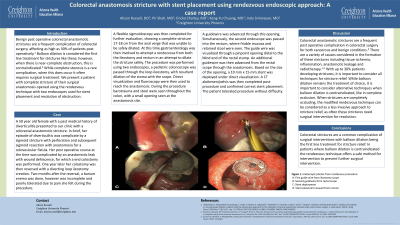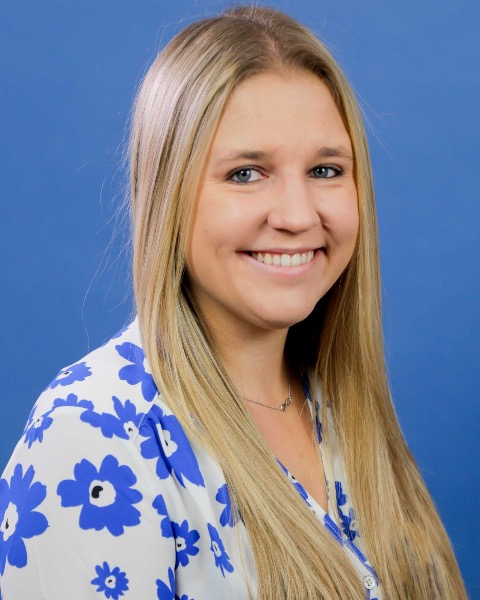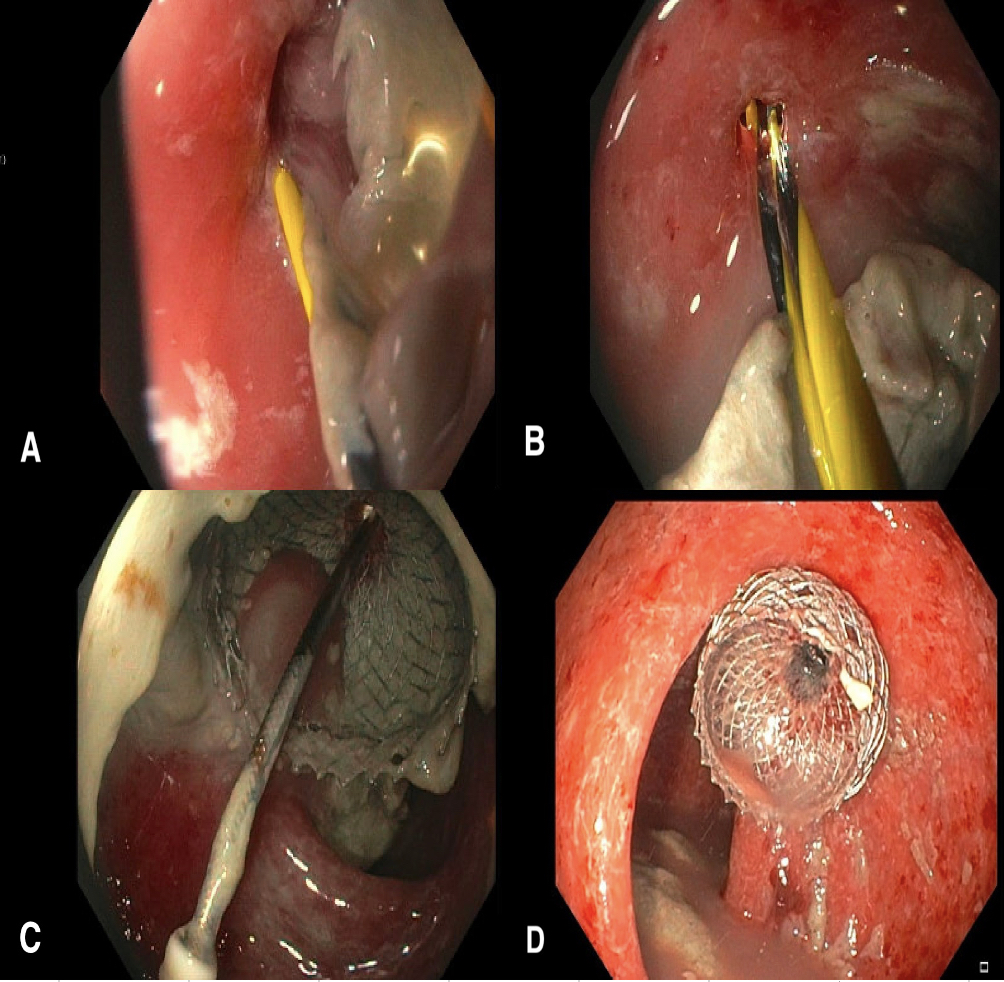Tuesday Poster Session
Category: Colon
P3697 - Colorectal Anastomosis Stricture With Stent Placement Using Rendezvous Endoscopic Approach: A Case Report
Tuesday, October 29, 2024
10:30 AM - 4:00 PM ET
Location: Exhibit Hall E

Has Audio

Alison Russell, DO
Creighton University Medical Center
Scottsdale, AZ
Presenting Author(s)
Alison Russell, DO1, Pir Shah, MD2, Ericka Charley, MD2, Keng-Yu Chuang, MD3, Indu Srinivasan, MD2
1Creighton University Medical Center, Scottsdale, AZ; 2Creighton University Medical Center, Phoenix, AZ; 3Creighton University Medical Center, Glendale, AZ
Introduction: Benign post operative colorectal anastomotic strictures are a frequent complication affecting as high as 30% of patients after colorectal surgery. Balloon dilation is considered first-line treatment for strictures; however, when there is near-complete obstruction, it is contraindicated. We present a patient with complete stricture of their surgical anastomosis opened using the rendezvous technique with two endoscopes for stent placement.
Case Description/Methods: A 50-year-old female with a history of diverticulitis presented to our clinic with colorectal anastomotic stricture. In brief, her episode of diverticulitis was complicated by sigmoid stricture with perforation and subsequent sigmoid resection with anastomosis for colovesicular fistula. Post operative course was complicated by an anastomotic leak with wound dehiscence, for which end colostomy was performed. A year later colostomy was reversed with diverting loop ileostomy creation. A barium enema was completed 2 months post-ileostomy, but was incomplete and poorly tolerated due to pain. A flexible sigmoidoscopy was then completed for further evaluation, showing a complete stricture 17-18 cm from the anal verge that was unable to be safely dilated. Gastroenterology was then involved to attempt a rendezvous from both the ileostomy and rectum in an attempt to dilate the stricture safely. The procedure was performed using two endoscopes, a pediatric colonoscope was passed through the loop ileostomy, with resultant dilation of the stoma with the scope. Direct visualization and fluoroscopy were used to reach the anastomosis. Barotrauma and stool were seen throughout the colon, with a small opening seen at the anastomosis site. A guidewire was advanced through the opening. Simultaneously, the second endoscope was passed to the rectum, where friable mucosa and retained stool were seen. The guidewire was visualized through a pinpoint opening distal to the blind end of the rectal stump. An additional guidewire was then advanced from the rectal scope through the anastomosis. Based on the size of the opening, a 10 mm x 15 mm stent was deployed under direct visualization. A CT abdomen/pelvis post-procedure confirmed stent placement.
Discussion: With postoperative colorectal anastomotic strictures being a frequent complication, it is important to consider alternate techniques for stricture relief when balloon dilation is contraindicated. The rendezvous technique offers a safe method for intervention on these strictures.

Disclosures:
Alison Russell, DO1, Pir Shah, MD2, Ericka Charley, MD2, Keng-Yu Chuang, MD3, Indu Srinivasan, MD2. P3697 - Colorectal Anastomosis Stricture With Stent Placement Using Rendezvous Endoscopic Approach: A Case Report, ACG 2024 Annual Scientific Meeting Abstracts. Philadelphia, PA: American College of Gastroenterology.
1Creighton University Medical Center, Scottsdale, AZ; 2Creighton University Medical Center, Phoenix, AZ; 3Creighton University Medical Center, Glendale, AZ
Introduction: Benign post operative colorectal anastomotic strictures are a frequent complication affecting as high as 30% of patients after colorectal surgery. Balloon dilation is considered first-line treatment for strictures; however, when there is near-complete obstruction, it is contraindicated. We present a patient with complete stricture of their surgical anastomosis opened using the rendezvous technique with two endoscopes for stent placement.
Case Description/Methods: A 50-year-old female with a history of diverticulitis presented to our clinic with colorectal anastomotic stricture. In brief, her episode of diverticulitis was complicated by sigmoid stricture with perforation and subsequent sigmoid resection with anastomosis for colovesicular fistula. Post operative course was complicated by an anastomotic leak with wound dehiscence, for which end colostomy was performed. A year later colostomy was reversed with diverting loop ileostomy creation. A barium enema was completed 2 months post-ileostomy, but was incomplete and poorly tolerated due to pain. A flexible sigmoidoscopy was then completed for further evaluation, showing a complete stricture 17-18 cm from the anal verge that was unable to be safely dilated. Gastroenterology was then involved to attempt a rendezvous from both the ileostomy and rectum in an attempt to dilate the stricture safely. The procedure was performed using two endoscopes, a pediatric colonoscope was passed through the loop ileostomy, with resultant dilation of the stoma with the scope. Direct visualization and fluoroscopy were used to reach the anastomosis. Barotrauma and stool were seen throughout the colon, with a small opening seen at the anastomosis site. A guidewire was advanced through the opening. Simultaneously, the second endoscope was passed to the rectum, where friable mucosa and retained stool were seen. The guidewire was visualized through a pinpoint opening distal to the blind end of the rectal stump. An additional guidewire was then advanced from the rectal scope through the anastomosis. Based on the size of the opening, a 10 mm x 15 mm stent was deployed under direct visualization. A CT abdomen/pelvis post-procedure confirmed stent placement.
Discussion: With postoperative colorectal anastomotic strictures being a frequent complication, it is important to consider alternate techniques for stricture relief when balloon dilation is contraindicated. The rendezvous technique offers a safe method for intervention on these strictures.

Figure: Endoscopic photos from rendezvous procedure
A: First guide wire from ileostomy scope
B: Second guide wire from rectal scope with initial guide wire
C: Stent deployment
D: Stent placement viewed from rectum
A: First guide wire from ileostomy scope
B: Second guide wire from rectal scope with initial guide wire
C: Stent deployment
D: Stent placement viewed from rectum
Disclosures:
Alison Russell indicated no relevant financial relationships.
Pir Shah indicated no relevant financial relationships.
Ericka Charley indicated no relevant financial relationships.
Keng-Yu Chuang indicated no relevant financial relationships.
Indu Srinivasan indicated no relevant financial relationships.
Alison Russell, DO1, Pir Shah, MD2, Ericka Charley, MD2, Keng-Yu Chuang, MD3, Indu Srinivasan, MD2. P3697 - Colorectal Anastomosis Stricture With Stent Placement Using Rendezvous Endoscopic Approach: A Case Report, ACG 2024 Annual Scientific Meeting Abstracts. Philadelphia, PA: American College of Gastroenterology.
